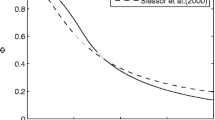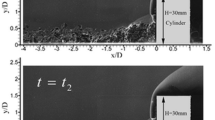Abstract
Direct numerical simulations of Mach 6 hypersonic flow over a 34° compression corner subject to steady jet are conducted. Distributions of skin friction coefficient, wall pressure, mean velocity and temperature, boundary layer thickness and Stanton number demonstrate that the flow changes dramatically in the shock wave/turbulent boundary layer interaction area. It is found that the steady jet has no effect on suppressing flow separation unexpectedly, but increases its spatial scale instead. Instantaneous flow structures show that the turbulence amplification can be observed after the application of flow control, and abundant Gortler-like vorticities appear, but the strength of the main shock decreases. Analyzing the wall fluctuating pressure signals using weighted power spectral density, we found an interesting thing. That is, although the low-frequency oscillation phenomenon induced by separation shock is suppressed by the steady jet, wall fluctuating pressure beneath the jet shock is oscillating at a frequency lower than 0.1u∞/δref. Results of coherent and intermittency factor reveal that it is related to the backand- forth movement of the jet shock itself.
摘要
对稳态射流作用下马赫6高超声速压缩拐角激波/湍流边界层干扰流动开展了直接数值模拟研究. 表面摩阻系数、壁面压力、 平均速度和温度、边界层厚度和斯坦顿数的分布等结果表明, 激波/湍流边界层相互作用区的流动发生了显著变化. 研究发现, 垂直壁 面的稳定射流对抑制流动分离没有任何作用, 反而增加了其空间尺度. 瞬时流动结构表明, 在施加流动控制后, 可以观察到湍流增强效 应, 并出现大量的类Görtler涡结构, 但主激波强度降低. 使用加权功率谱密度分析壁面脉动压力信号, 我们发现了一件有趣的事情: 尽管 稳定射流抑制了分离激波引起的低频振荡现象, 但射流激波附近的壁面脉动压力以低于0.1u∞/δref的频率振荡. 相干性和间歇性因子的 结果表明, 这与射流激波本身的往复运动有关.

Similar content being viewed by others
References
D. S. Dolling, Fifty years of shock-wave/boundary-layer interaction research: What next? AIAA J. 39, 1517 (2001).
G. Tu, J. Chen, X. Yuan, Q. Yang, M. Duan, Q. Yang, Y. Duan, X. Chen, B. Wan, and X. Xiang, Progress in flight tests of hypersonic boundary layer transition, Acta Mech. Sin. 37, 1589 (2021).
Q. Liu, Z. Luo, X. Deng, Y. Zhou, L. Wang, and P. Cheng, Vortical structures and density fluctuations analysis of supersonic forward-facing step controlled by self-sustaining dual synthetic jets, Acta Mech. Sin. 36, 1215 (2020).
S. Piponniau, J. P. Dussauge, J. F. Debiève, and P. Dupont, A simple model for low-frequency unsteadiness in shock-induced separation, J. Fluid Mech. 629, 87 (2009).
S. Pirozzoli, and F. Grasso, Direct numerical simulation of impinging shock wave/turbulent boundary layer interaction at M = 2.25, Phys. Fluids 18, 065113 (2006).
Z. Wang, J. Chang, W. Hou, and D. Yu, Low-frequency unsteadiness of shock-wave/boundary-layer interaction in an isolator with background waves, Phys. Fluids 32, 056105 (2020).
S. Hickel, and B. van Oudheusden, Influence of upstream disturbances on the primary and secondary instabilities in a supersonic separated flow over a backward-facing step, Phys. Fluids 32, 056102 (2020).
N. T. Clemens, and V. Narayanaswamy, Low-frequency unsteadiness of shock wave/turbulent boundary layer interactions, Annu. Rev. Fluid Mech. 46, 469 (2014).
X. H. Fan, Z. G. Tang, G. Wang, and Y. G. Yang, Review of low frequency unsteadiness in shock wave/turbulent boundary layer interaction (in Chinese), Acta Aeronaut. Astronaut. Sin. 43, 625917 (2022).
L. Vanstone, and N. T. Clemens, Proper orthogonal decomposition analysis of swept-ramp shock-wave/boundary-layer unsteadiness at Mach 2, AIAA J. 57, 3395 (2019).
R. A. Humble, G. E. Elsinga, F. Scarano, and B. W. van Oudheusden, Three-dimensional instantaneous structure of a shock wave/turbulent boundary layer interaction, J. Fluid Mech. 622, 33 (2009).
Y. Zhuang, H. Tan, X. Li, F. Sheng, and Y. Zhang, Letter: Görtler-like vortices in an impinging shock wave/turbulent boundary layer interaction flow, Phys. Fluids 30, 061702 (2018).
W. Wu, C. Meneveau, and R. Mittal, Spatio-temporal dynamics of turbulent separation bubbles, J. Fluid Mech. 883, A45 (2020).
K. M. Porter, and J. Poggie, Selective upstream influence on the unsteadiness of a separated turbulent compression ramp flow, Phys. Fluids 31, 016104 (2019).
M. P. Martin, S. Priebe, and C. M. Helm, Upstream and downstream influence on STBLI instability, AIAA Paper No. 2016-3341, 2016.
F. Tong, S. Dong, J. Duan, X. Yuan, and X. Li, Effect of expansion on the wall heat flux in a supersonic turbulent boundary layer, Phys. Fluids 34, 105109 (2022).
F. Tong, S. Dong, J. Lai, X. Yuan, and X. Li, Wall shear stress and wall heat flux in a supersonic turbulent boundary layer, Phys. Fluids 34, 015127 (2022).
F. Tong, X. Yuan, J. Lai, J. Duan, D. Sun, and S. Dong, Wall heat flux in a supersonic shock wave/turbulent boundary layer interaction, Phys. Fluids 34, 065104 (2022).
B. Wang, W. D. Liu, Y. X. Zhao, X. Q. Fan, and C. Wang, Experimental investigation of the micro-ramp based shock wave and turbulent boundary layer interaction control, Phys. Fluids 24, 055110 (2012).
M. Tang, Y. Wu, H. Zong, S. Guo, H. Liang, and Y. Luo, Experimental investigation on compression ramp shock wave/boundary layer interaction control using plasma actuator array, Phys. Fluids 33, 066101 (2021).
L. Feng, H. Wang, Z. Chen, Y. Zhou, and Y. Yang, Unsteadiness characterization of shock wave/turbulent boundary layer interaction controlled by high-frequency arc plasma energy deposition, Phys. Fluids 33, 015114 (2021).
X. Geng, W. Zhang, Z. Shi, Z. Li, Q. Sun, and Z. Sun, Experimental study on frequency characteristics of the actuations produced by plasma synthetic jet actuator and its geometric effects, Phys. Fluids 33, 067113 (2021).
E. Touber, and N. D. Sandham, Low-order stochastic modelling of low-frequency motions in reflected shock-wave/boundary-layer interactions, J. Fluid Mech. 671, 417 (2011).
V. Narayanaswamy, L. L. Raja, and N. T. Clemens, Control of unsteadiness of a shock wave/turbulent boundary layer interaction by using a pulsed-plasma-jet actuator, Phys. Fluids 24, 076101 (2012).
M. Y. Ali, F. Alvi, C. Manisankar, S. Verma, and L. Venkatakrishnan, in Studies on the control of shock wave-boundary layer interaction using steady microactuators: Proceedings of 41st AIAA Fluid Dynamics Conference and Exhibit, Honolulu, 2011.
S. B. Verma, and C. Manisankar, Control of compression-ramp-induced interaction with steady microjets, AIAA J. 57, 2892 (2019).
B. Ganapathisubramani, N. T. Clemens, and D. S. Dolling, Low-frequency dynamics of shock-induced separation in a compression ramp interaction, J. Fluid Mech. 636, 397 (2009).
J. Liu, and J. Luo, Effect of disturbances at inlet on hypersonic boundary layer transition on a blunt cone at small angle of attack, Appl. Math. Mech.-Engl. Ed. 31, 535 (2010).
X. L. Li, D. X. Fu, Y. W. Ma, and X. Liang, Direct numerical simulation of compressible turbulent flows, Acta Mech. Sin. 26, 795 (2010).
R. Hu, X. Li, and C. Yu, Transfers of energy and helicity in helical rotating turbulence, J. Fluid Mech. 946, A19 (2022).
Q. Liu, Z. Luo, G. Tu, X. Deng, P. Cheng, and P. Zhang, Direct numerical simulations of a supersonic turbulent boundary layer subject to velocity-temperature coupled control, Phys. Rev. Fluids 6, 044603 (2021).
S. Dong, F. Tong, M. Yu, J. Chen, X. Yuan, and Q. Wang, Positive and negative pairs of fluctuating wall shear stress and heat flux in supersonic turbulent boundary layers, Phys. Fluids 34, 085115 (2022).
L. Duan, I. Beekman, and M. P. Martín, Direct numerical simulation of hypersonic turbulent boundary layers. Part 2. Effect of wall temperature, J. Fluid Mech. 655, 419 (2010).
P. Schlatter, and R. Örlü, Assessment of direct numerical simulation data of turbulent boundary layers, J. Fluid Mech. 659, 116 (2010).
M. V. Morkovin, Effects of compressibility on turbulent flows, in: In Mecanique de la Turbulence, edited by A. Favre, (CNRS, Paris, 1962), pp. 367–380.
F. M. White, Viscous Fluid Flow (McGraw-Hill, New York, 1974).
H. Qi, X. Li, X. Ji, F. Tong, and C. Yu, Large-eddy simulation of a hypersonic turbulent boundary layer over a compression corner, AIP Adv. 13, 025265 (2023).
M. Wu, and M. P. Martin, Direct numerical simulation of supersonic turbulent boundary layer over a compression ramp, AIAA J. 45, 879 (2007).
J. Jeong, and F. Hussain, On the identification of a vortex, J. Fluid. Mech. 285, 69 (1995).
I. Tani, Production of longitudinal vortices in the boundary layer along a concave wall, J. Geophys. Res. 67, 3075 (1962).
M. Wu, and M. P. Martín, Analysis of shock motion in shockwave and turbulent boundary layer interaction using direct numerical simulation data, J. Fluid Mech. 594, 71 (2008).
Acknowledgements
This work was supported by the National Natural Science Foundation of China (Grant Nos. 12202488 and 12002377), the Natural Science Program of National University of Defense Technology (Grant No. ZK22-30), and Independent Cultivation Project for Young Talents in College of Aerospace Science and Engineering. Supercomputer time provided by the National Supercomputing Center in Beijing is also gratefully acknowledged.
Author information
Authors and Affiliations
Contributions
Qiang Liu: Data curation, Formal analysis, Funding acquisition, Investigation, Resources, Methodology, Visualization, Writing — original draft. Wei Xie: Data curation, Visualization, Validation, Methodology. Zhenbing Luo: Conceptualization, Writing — review & editing, Resources. Mingbo Sun: Writing — review & editing, Resources, Software. Pan Cheng: Project administration, Writing — review & editing. Xiong Deng: Writing — review & editing, Resources, Methodology. Yan Zhou: Writing — review & editing, Funding acquisition.
Corresponding author
Ethics declarations
On behalf of all authors, the corresponding author states that there is no conflict of interest.
Rights and permissions
About this article
Cite this article
Liu, Q., Xie, W., Luo, Z. et al. Flow structures and unsteadiness in hypersonic shock wave/turbulent boundary layer interaction subject to steady jet. Acta Mech. Sin. 39, 123202 (2023). https://doi.org/10.1007/s10409-023-23202-x
Received:
Accepted:
Published:
DOI: https://doi.org/10.1007/s10409-023-23202-x




